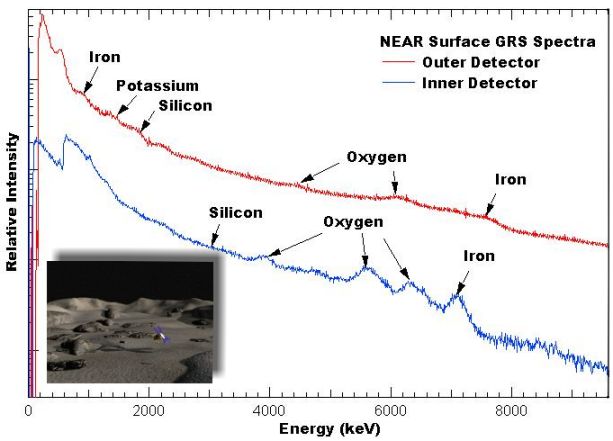
|
Credit & Copyright: NEAR Project,
NASA
Explanation:
Not part of a television game series, the
NEAR Shoemaker
spacecraft survived
its unprecedented landing on an
on asteroid last month.
As suggested in the
illustration
inset above, the car-sized probe
likely rests gently on the tips of its solar panels
having touched down under the
influence of asteroid Eros' feeble gravity.
Fortunately, the spacecraft's solar panels were bathed in sunlight and
able to power
NEAR's gamma-ray spectrometer.
Perched on the asteroid, this instrument can determine the composition
of Eros to a depth of about 10 centimeters
with unanticipated accuracy
by measuring
the
gamma-ray signatures of the atomic nuclei present.
The data returned from the surface of Eros are plotted above
and show clearly features corresponding to Iron, Oxygen, Silicon, and
Potassium in the asteroid's regolith.
Also briefly operating on Eros,
NEAR's magnetometer has indicated that no surface
magnetic field is discernible.
Now turned off, NEAR Shoemaker could remain preserved
in its present location, the vicinity of the huge, saddle-shaped feature
dubbed Himeros, for billions of years.
But, as the
asteroid orbits, the spacecraft's solar panels
will be repeatedly turned toward the Sun ... offering the possibility
of reawakening this survivor.
|
January February March April May June July August September October November December |
| ||||||||||||||||||||||||||||||||||||||||||||||||
NASA Web Site Statements, Warnings, and Disclaimers
NASA Official: Jay Norris. Specific rights apply.
A service of: LHEA at NASA / GSFC
& Michigan Tech. U.
Based on Astronomy Picture
Of the Day
Publications with keywords: Eros - landing - gamma ray - asteroid
Publications with words: Eros - landing - gamma ray - asteroid
See also:
